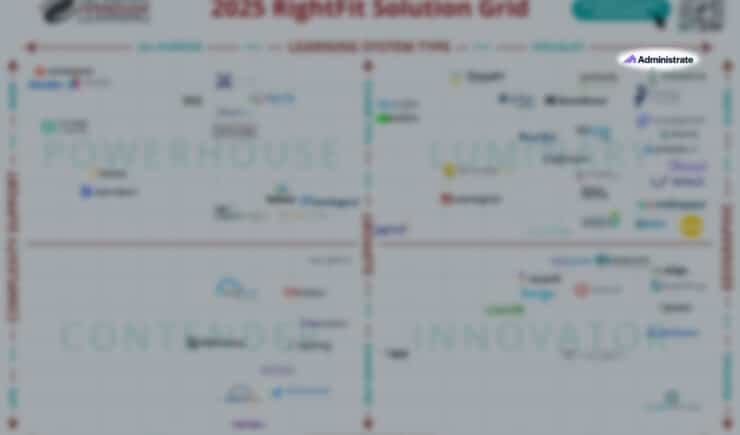A great place to start building a sophisticated learning analytics solution is by prioritizing data emerging at the intersection of training metrics and organizational objectives. This is the rubber-meets-the-road moment for L&D teams that want to reach true data-driven decision making.
Let’s identify blockers to finding and assessing this data, reveal which attributes are critical to learning analytics, and understand how to use this data once we’ve captured it.
Jump Right In: [GUIDE] How to Design Learning Analytics
Identifying the Gap Between Business & Learning Systems
Before we can identify and assess data at the critical junction of training and business goals, we have to be honest about the gap between these parts of our business. This gap often spans both our strategic thinking and our technology.
How to Tap into Learning Analytics
Adopting learning analytics is a mindset shift: what is important to the training team and why? What is important to the business at large and how do we connect training?
For years, we’ve been focused on training metrics: course completion rates, learner engagement, and instructor evaluations. These reports often focus only on one-to-one relationships between the data and the activity source. These activity metrics don’t show impact, or tell a story. There isn’t context or analysis happening on the data that’s been captured.
Critically, these metrics aren’t useful for mapping training impact on organizational goals.
What are useful are metrics that focus on tangible outcomes to business goals. Some examples of business-oriented outcomes that are important are:
- Employee turnover/ retention rates
- On-job performance improvements
- Cross-functional performance improvements
- Onboarding cost or resource improvements
When presented with business goals, work backwards to find which training metrics can show business impact. The key is connecting metrics you are already scoring with business goals you need to meet. Reporting just on course completion rates isn’t enough, you must address business critical questions such as:
- How did an uptick in completion rates impact employee turnover?
- Why is actual daily performance decreasing after course completion?
Typically, we rely on a combination of measured results and self-assessment surveys from learners and managers. But the truth is, self-assessments may not be very useful: business leadership will only care about final results.
Once you’ve identified how to connect your learning analytics to tangible outcomes – no small feat – you’re ready to scope the technology gap between learning analytics and business goals.
Scope Your Learning Technology Gap
Learning technology is typically purchased to solve a single problem. To build a solution for training operations, content management, and training administration your team will eventually create a maze of disconnected tech – held together with spreadsheets and cumbersome processes.
Evaluate the technology you have on hand to understand how your existing tech can block your data-inspired ambitions.
Is the tech focused on a single outcome? If so, is it worth the effort to keep that tech around or can it be replaced with something that does more with fewer upkeep or maintenance requirements? Is your technology connecting business systems and goals to learning analytics? Think: business-wide CRM, HRIS systems, financial systems, and databases – these are the systems that should be integrated with your learning technology.
Often, the strategic outcome you need – connecting course completion to daily performance improvements – will fall short if your learning technology isn’t capable of business system integrations. Here’s what to look for in your learning technology:
- Does this solution connect to larger business systems in any capacity?
- How much effort does it take to modify data captured by the solution? Can data be analyzed with a no-code reporting engine or do you need a developer to help you out?
- Can the solution share training data with other systems? If so, how effective is it?
- Can you configure the solution to connect with new systems?
Use Training Metrics You Have to Show Business Impact
Once you’ve scoped the gap between business and learning systems, it’s time to start identifying and accessing the data that emerges from this critical junction.
Here’s the secret: that data is something you already have on hand.
We are going to rethink how we use activity metrics to tell our story and show training’s impact on the business. So, start with metrics you already have – likely data such as course engagement information, completion rates, and event signup data.
These metrics can come from a host of tools and solutions – from your LMS to event signup data and user surveys. You’re likely already capturing this data in reports and spreadsheets, but we need to understand how this data impacts business goals.
How to Assess Data: The Attributes of Learning Analytics
There are six attributes that define learning data and form the foundation for learning analytics. You should evaluate all of your existing training metrics against these attributes. If you have data that doesn’t have any useful attributes, it may not be worth analyzing further.
Look for trends and patterns, especially trends that indicate change in your business.
- Measurable – anything actionable has to be measurable, but this doesn’t mean you only focus on quantitative numbers.
- Repeatable – is the data indicating a trend? If so, what is the trend pointing to? Look for patterns in your data.
- Actionable – is the data something you can use to make a decision? If you’re taking the time to capture it, it should be actionable.
- Reportable – Can you report on the data’s impact? Or is it stuck in a spreadsheet without context? Many tools fail to report the context of data because they lack visibility into other systems.
- Relatable – How does this data relate to business goals, and other L&D goals?
- ROI Oriented – Does this data show ROI? If it absolutely cannot, you should not prioritize the data.
How to Turn Captured Data into Something Useful
You are aware of blockers in your mindset and learning technology stack. You have a list of useful attributes to access and evaluate metrics you have on hand. The next step is to gather that data and store it. But, we don’t want to just let the data fester. This is where the really hard work begins.
Consider a Training Management System
Until now, training teams haven’t had an option for a training management system. A platform is not a single solution, it is a cohesive ecosystem that provides infrastructure for digital transformation.
Using software as infrastructure isn’t unusual for data-driven, outcome-focused teams.
Look at Sales and Marketing. Both of these business functions have been completely transformed over the past twenty years by software like Salesforce, Marketo, and HubSpot. This software acts as a platform connecting various business systems into a unified solution.
There are options in the L&D space that take the same approach to training data. A training management system keeps the learner experience front and center but connects data behind the scenes to reveal the important correlations between training and business outcomes.
A training operations infrastructure, backed by a new mindset, will help you show training ROI to business leadership.
[A Guide] How High-Performing Training Teams Leverage Learning Analytics
Organizations that focus on capturing and analyzing data that shows how training metrics impact organizational objectives, are leading the change in learning analytics. We’ve gathered stories from training leaders who’ve made the journey. Follow their path in our guide.


.png)




